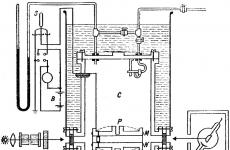Do I need to remove the film from the inside. Cellular polycarbonate. What to do if the coating "stuck"
Transparent hard polymer plastic, or polycarbonate, is widely used in various fields of activity, in particular in construction and agriculture. Today we will tell you how to remove the film from polycarbonate.
Why do you need a film
Monolithic and cellular polycarbonate has good light transmission, which is important for the growth and development of fruit and vegetable crops grown in greenhouses. The lack or lack of sunlight negatively affects fruiting, and sudden temperature changes lead to the death of plants. The polymer plastic sheathing maintains a favorable microclimate inside the greenhouse.
Many gardeners are interested in what purpose a special protective coating on the surface of the canvas has. It should be noted that a variety of chips, microcracks, scratches, dents and other mechanical damage lead to a deterioration or complete loss of the original physical properties and qualities of the material. It is impractical to use such a cloth for covering the greenhouse.
The light transmission of half carbonate is considered one of the main parameters.
A special protective surface coating is necessary for loading and unloading operations, transportation and installation of polymer plastic.
High-quality honeycomb-type polycarbonate must be protected on both sides. In this case, one side is covered with a transparent colorless film, and the other is covered with a colored one. Colored polyethylene indicates the UV side.
Responsible manufacturers apply the following markings to the film:
- name and technical characteristics of the material;
- information about the manufacturing plant and trade mark;
- recommendations for the installation of polymer plastic.
Video "Protective film on polycarbonate"
From this video you will learn how to properly remove the film from cellular polycarbonate:
Inside coating
It is necessary to remove the protective layer from the inside of the sheet at the end of the installation of polymer plastic. If construction work is carried out on a hot summer day, you should rush to remove the protective coating. Otherwise, the polyethylene will "stick" to the canvas.
The protective film is removed from the edge to the center, while the movements should be neat and unhurried. It is forbidden to scratch the special coating with various tools, devices and even nails - there is a high risk of damage to the integrity of the material surface.
If the film does stick to the polymer plastic sheet, you can use one of the popular methods: wet the surface of the sheet with warm water with the addition of liquid baby soap or dishwashing detergent, leave it for a few minutes, remove the protective layer with a soft foam sponge.
Outside coating
The back side of cellular polycarbonate can have a colorless or colored film. A colorless special coating indicates that this polymer plastic sheet does not have UV protection. Accordingly, the service life of such material is no more than 2-3 years.
 If the outer side of the film is transparent, then this polycarbonate sheet does not have UV protection.
If the outer side of the film is transparent, then this polycarbonate sheet does not have UV protection. It is imperative to remove the protective layer. Residual polyethylene will damage the UV protection layer and deteriorate the technical properties of the polycarbonate.
It is not difficult to work with sheets of cellular polycarbonate if you follow the advice of more experienced farmers and the recommendations of the manufacturer.
There is a special coating to protect the plastic panels from damage during loading and unloading, transportation and assembly. At the end of the installation work, it is recommended to remove it. Otherwise, under the influence of solar heat, the film heats up until it melts and "sticks" to the surface of the sheet. After that, it is quite difficult to remove it.
This often happens after installation in the summer. A protective layer that is not removed in time causes a lot of trouble. For example, in winter snow will accumulate on this one - it slides well only from clean polycarbonate sheets.
What to do if the coating "stuck"
The film can bond very strongly with polycarbonate. In this case, it is better to do nothing. Some people try to warm up the film (for example, with a regular hair dryer). But this leads to the fact that it only adheres more strongly to polycarbonate.
All you can do is wait. One season after installation, the film itself will move away from the outside. But for it to be easy to remove inside, it will take time. It is not recommended to scrape or scratch the polycarbonate surface - otherwise it is easy to damage the material.
Caution: UV protection
There may be another layer on the panels. It protects against UV rays and can be easily damaged too. Then the surface of the sheets will become cloudy, cracks will appear on it.
How do you know where the UV protective layer is? It is necessary to inspect the packaging with cellular polycarbonate. Where the plates are equipped with UV protection, there are always inscriptions, service pictograms. It is with this marked side that polycarbonate faces the sun during installation. By the way, the UV layer is invisible, and it is impossible to accidentally remove it together with the transport film (only if it "sticks").

We shoot on time and accurately
There is also a coating on the inside of the sheets. It is usually completely transparent. It also needs to be removed - then the polycarbonate will better transmit light. If this inner protective layer is left on, it will deteriorate over time, affecting the appearance of the structure.
What can I do to gently peel off the film? Dampen the sheets with lukewarm water mixed with a household detergent, such as kitchen utensils. This will allow you to neatly and without any problems separate the protective film from the polycarbonate.
What is the risk of untimely removal of the protective film from the surface of polycarbonate sheets? The strength of the structure, which is made of polycarbonate sheets, largely directly depends on the specific conditions in which this material was stored. A decrease in its performance will further jeopardize the durability of the structure and its reliability. The company, an official dealer of many manufacturers of this building material, guarantees that by purchasing ready-made structures or polycarbonate sheets from us, you will receive a quality product that has been 100% competently stored and transported from its manufacturer.If you plan to manufacture any structures from a material such as polycarbonate, for example, awnings and canopies, then you should know that the protective film is attached to the polycarbonate sheet using a special glue. Prolonged exposure of the polycarbonate sheet, for example, under direct sunny sheets or in the open air, directly provokes a very strong adhesion of the surface of the material and the film, and this significantly complicates its further removal. It is best to remove the protective film immediately after installing the structure.
The use of various techniques for installing sheets of polycarbonate not provided for by the manufacturer of polycarbonate, for example, such as: welding, bending along stiffeners, bending with a notch, gluing - all these techniques relieve the polycarbonate manufacturer from all responsibility for the reliability and strength of the material used, even if you were able to buy high quality monolithic polycarbonate.
When storing polycarbonate sheets in the open air, there is a danger that the sheet will be turned towards the sun exactly on the side on which there is no UV protection at all. This, in the end, in addition to strong adhesion of the protective film, as mentioned above, will also lead to yellowing of the sheet, a decrease in its operational characteristics or even to its complete destruction. In addition, it is impossible to store polycarbonate sheets with unprotected ends - it is its open ends that significantly contribute to the ingress of moisture, dust and dirt into the honeycomb of the polycarbonate sheet. All these factors significantly contribute to a large decrease in the durability of the polycarbonate product and, naturally, put its strength at risk.
In addition, there are quite significant mistakes that are made when transporting polycarbonate sheets. Today, the main and most common mistake in the transportation process of polycarbonate products is rolling them into rolls of a much smaller radius than is allowed for the thickness of a particular sheet. This, naturally, provokes the appearance of breaks and cracks on the surface of the sheet and significantly reduces the ability of the polycarbonate sheet to bear a certain load during the construction made from it.
Popular articles:
Sheets of polymer plastic known as polycarbonate, while lightweight, are very durable and transmit light well. Cellular polycarbonate is most widely used in home construction. It is widely used in the manufacture of awnings and greenhouses. Knowledge of some basic installation rules, including which side to lay polycarbonate, will help to avoid unforeseen complications and make the structure reliable and durable.
Material features
The product of the chemical production got its name from the external resemblance, in cross section, with a honeycomb honeycomb structure. Plates of cellular polycarbonate consist of several polymer sheets, they are connected to each other by longitudinal bridges, which give strength to the plate, performing the function of stiffening ribs. The number of layers can be from two to four. This structure gives polycarbonate good thermal insulation properties.
Transmitting more than 90% of the light flux, polycarbonate is a hundred times stronger than glass, and at the same time has good flexibility. This quality makes it convenient to use in the manufacture of arched canopies. Important for awnings is the good resistance of polycarbonate to mechanical damage. After impacts, cracks do not appear on it, so polycarbonate will withstand hail of any size.

Polycarbonate coating
All types of polycarbonate are covered with a film that prevents the damaging effects of ultraviolet radiation. In addition, the front side of the sheet has a special coating (selective) capable of transmitting a certain part of the luminous flux spectrum.

In order not to be mistaken during installation, which side to lay the polycarbonate, sheets are produced with a protective film of various colors. The underside of the sheet is always covered with a white or transparent film. On the upper side, the film is blue, it can have a picture or printed markings. In any case, the top side is significantly different from the bottom. It is advisable to remove the protective film immediately before installing the panels or at the end of the installation.

There is polycarbonate that has the same protective film on both sides. On such sheets, there is a protective layer on both sides. During installation, it does not matter which side it will be laid up.
With proper installation and adherence to the installation technique, the erected structure (shed or greenhouse) with a roof made of cellular polycarbonate will stand for many years.
Do you like juicy peppers? Then find out how to build effortlessly for growing pepper, the recommendations of experienced summer residents will help you.
If you want to glue polycarbonate sheets together, then study this article - , we will help you choose the right and quality glue.
After buying polycarbonate, many people ask themselves the question - is it necessary to rip off the film from it after installation, because with it the design looks more colorful and attractive? You can see in some areas of private houses very colorful film coverings, which depict fruits, vegetables or other objects. When a person mounts a structure made of this material for the first time, he is cast into doubts about its beautiful appearance - remove the film or leave it for decoration? On the one hand, the film is pleasing to the eye, and on the other, will it harm you? So the correct answer to this question is, of course, it is necessary, otherwise some problems may arise with the material later. By the way, if you need polycarbonate, follow this link http://unistframe.ru/catalog/monolitnyy-polikarbonat/.
The film on the sheets is exclusively for transportation; it protects their surface during transportation and storage in a warehouse. Once the film has been purchased and installed in its place, it is no longer needed. Sometimes people who are not very knowledgeable in this matter take the transport protective layer for a film designed to protect the sheet from ultraviolet radiation. For reference, the UV-retaining layer is transparent, very difficult to see with the naked eye and very difficult to erase. Therefore, do not worry about removing the UV protection along with the protective film.
Cellular or monolithic polycarbonate from the inside and outside
Cellular or monolithic polycarbonate has an outer surface and an inner one. On the outside, as a rule, the name of the brand, manufacturer, product warranty and data on the available protection against UV rays are applied. This side is always colored, sometimes even decorated with drawings.
If you do not remove this colored film, the dark areas of the pattern applied to it will firmly adhere to the polycarbonate, dismantling the film, covered with rags, darkened and lost all its appearance, becomes quite problematic. In this situation, together with the protective film, the sun protection can also be dismantled, the film will firmly stick to it and damage it. In addition, in winter, it will slow down the snow, while on a clean surface it would easily come off.
Do I need to remove the film from the polycarbonate on the inside of the sheet? Here, the coating is most often completely transparent, but it also needs to be removed, since the film traps light. If you leave it, then in a couple of years it will disrupt the appearance of the product.






